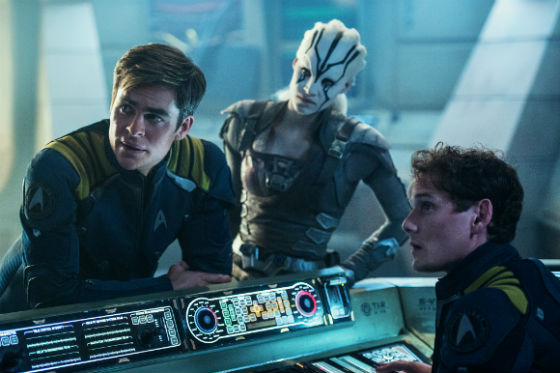Star Trek Beyond

Left to right: Chris Pine plays Captain James T. Kirk, Sofia Boutella plays Jaylah and Anton Yelchin plays Chekov in Star Trek Beyond from Paramount Pictures, Skydance, Bad Robot, Sneaky Shark and Perfect Storm Entertainment Photo Credit: Kimberly French

Photo Credit: Kimberly French
STAR TREK BEYOND did everything right. The story focused on interpersonal relationships of the principals, disrupted with an unexpected crisis which sets a plot in motion involving a villain motivated by the belief that he’s doing the right thing, necessitating the aid of a resourceful escapee (Jayla, a spirited homage to Jennifer Lawrence’s Ree Dolly in WINTER’S BONE, played by Sofia Boutella). Everything it does right is also everything STAR TREK BEYOND does wrong.
Directed by Justin Lin, written by Simon Pegg (who plays Cmdr. Montgomery “Scotty” Scott) and Don Jung, the third chapter in the Star Trek reboot opens with a distress call from a stranded vessel lures the crew of the USS Enterprise into a familiar no-win scenario (see Kobayashi Maru): a marooned villain, Krall (Idris Elba), seeks vengeance against Captain Kirk and the United Federation of Planets toward whom he directs his misguided wrath.
At its best, STAR TREK BEYOND adopts the spartan qualities of the 1966 serial which inspired the franchise, balancing between action, tension and character dynamics that produce situational humor naturally leading into catharsis. At worst, Lin’s first foray into science fiction de-orbits into the baneful territory of fast edits and nauseating camera movements. Poignant moments are set up, but never given a chance to breathe as if the studio’s financiers were constantly pointing at their wristwatches reminding the creative team that time is money.
This is most evident in the film’s climactic confrontation which, aside from being punctuated by the wrong rap song, zigs when it should have zagged. That is, and without spoiling it, Trek’s strength rested in its life lessons. It’s been said that Gene Roddenberry was at odds with the militaristic direction in which Nick Meyer took the franchise as he set about depicting, by self-admission, “Horatio Hornblower in space”, i.e. THE WRATH OF KHAN. This was a reaction to the excessive criticism leveled at STAR TREK: THE MOTION PICTURE, mocked for Robert Wise’s pacing (sometimes derided as THE MOTIONLESS PICTURE).
Some readers may feel that TREK’s mottled cinematic history (save for THE VOYAGE HOME) grants clemency to this effort, but that’s perhaps too generous. Paramount never learned from its mistakes and continued to speculate on “franchise fatigue” when the problem was really narrative weakness. At the exact moment you think fifty years of experience has finally paid off and the studio that passed on STAR WARS might finally believe in the appeal of redemptive stories, the old “dispatch the villain out the airlock” denouement happens.
Sure, TREK BEYOND is an entertaining ride… But that, and not Cmdr. Sulu’s (John Cho) sexual orientation, is at the center of why the J.J. Abrams-produced reboot runs afoul of the spirit of what STAR TREK was always about: Tackling complex social issues with inventive and diplomatic workarounds. Relying on violence to captivate audiences has always been the franchise’s Achilles’ heel–before Abrams, and well before Braga and Berman.
Footnote: Some will recall in my INTO DARKNESS review an observation, seemingly prescient in hindsight, comparing the action-obsessive reboot to THE FAST AND THE FURIOUS franchise, the fifth and sixth installments of which were helmed by Justin Lin. In all fairness to Lin, the film feels distinctively like Pegg and Lin worked very hard to undo the Bob Orci clusterfuck, both on and off-screen. Studios are notorious for sending “notes” to the creative team… basically edicts from the financial backers that demand changes since they are, after all, footing the bill. Among those changes, I suspect, is the pivotal ending. You can even see, in slow motion, the exact moment at which the studio likely forced Lin to change course in favor of playing it safe. Granted, this is just speculation (or not; Cho revealed they did in fact cut out a kiss between Sulu and his husband) but I encourage Trek fans and newcomers to see it and decide for yourself if I’m on to something. Not for nothing, but Bob Orci, while removed as director, remained on as producer… you know, one of those assholes who sends notes.